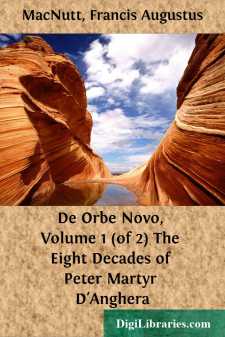Categories
- Antiques & Collectibles 13
- Architecture 36
- Art 48
- Bibles 22
- Biography & Autobiography 813
- Body, Mind & Spirit 142
- Business & Economics 28
- Children's Books 15
- Children's Fiction 12
- Computers 4
- Cooking 94
- Crafts & Hobbies 4
- Drama 346
- Education 46
- Family & Relationships 57
- Fiction 11829
- Games 19
- Gardening 17
- Health & Fitness 34
- History 1377
- House & Home 1
- Humor 147
- Juvenile Fiction 1873
- Juvenile Nonfiction 202
- Language Arts & Disciplines 88
- Law 16
- Literary Collections 686
- Literary Criticism 179
- Mathematics 13
- Medical 41
- Music 40
- Nature 179
- Non-Classifiable 1768
- Performing Arts 7
- Periodicals 1453
- Philosophy 64
- Photography 2
- Poetry 896
- Political Science 203
- Psychology 42
- Reference 154
- Religion 513
- Science 126
- Self-Help 84
- Social Science 81
- Sports & Recreation 34
- Study Aids 3
- Technology & Engineering 59
- Transportation 23
- Travel 463
- True Crime 29
De Orbe Novo, Volume 1 (of 2) The Eight Decades of Peter Martyr D'Anghera
Description:
Excerpt
I
Distant a few miles from the southern extremity of Lago Maggiore, the castle-crowned heights of Anghera and Arona face one another from opposite sides of the lake, separated by a narrow stretch of blue water. Though bearing the name of the former burgh, it was in Arona[1], where his family also possessed a property, that Pietro Martire d'Anghera first saw the light, in the year 1457[2]. He was not averse to reminding his friends of the nobility of his family, whose origin he confidently traced to the Counts of Anghera, a somewhat fabulous dynasty, the glories of whose mythical domination in Northern Italy are preserved in local legends and have not remained entirely unnoticed by sober history. What name his family bore is unknown; the statement that it was a branch of the Sereni, originally made by Celso Rosini and repeated by later writers, being devoid of foundation. Ties of relationship, which seem to have united his immediate forebears with the illustrious family of Trivulzio and possibly also with that of Borromeo, furnished him with sounder justification for some pride of ancestry than did the remoter gestes of the apocryphal Counts of Anghera.[3]
[Note 1: Ranke, in his Zur Kritik neuerer Geschichtsschreiber, and Rawdon Brown, in his Calendar of State Papers relating to England, preserved in the Archives of Venice, mention Anghera, or Anghiera, as the name is also written, as his birthplace. Earlier Italian writers such as Piccinelli (Ateneo de' Letterati Milanesi) and Giammatteo Toscano (Peplus Ital) are perhaps responsible for this error, which passages in the Opus Epistolarum, that inexplicably escaped their notice, expose. In a letter addressed to Fajardo occurs the following explicit statement: "... cum me utero mater gestaret sic volente patre, Aronam, ubi plæraque illis erant prædia domusque ... ibi me mater dederat orbi." Letters 388, 630, and 794 contain equally positive assertions.]
[Note 2: Mazzuchelli (Gli Scrittori d'Italia, p. 773) states that Peter Martyr was born in 1455, and he has been followed by the Florentine Tiraboschi (Storia della Letteratura Italiana, vol. vii.) and later historians, including even Hermann Schumacher in his masterly work, Petrus Martyr der Geschichtsschreiber des Weltmeeres. Nicolai Antonio (Bibliotheca Hispana nova, app. to vol. ii) is alone in giving the date as 1559. Ciampi, amongst modern Italian authorities (Le Fonti Storiche del Rinascimento) and Heidenheimer (Petrus Martyr Anglerius und sein Opus Epistolarum) after carefully investigating the conflicting data, show from Peter Martyr's own writings that he was born on February 2, 1457. Three different passages are in agreement on this point. In Ep. 627 written in 1518 and referring to his embassy to the Sultan of Egypt upon which he set out in the autumn of 1501, occurs the following: ... quatuor et quadraginta tunc annos agebam, octo decem superadditi vires illas hebetarunt. Again in Ep. 1497: Ego extra annum ad habitis tuis litteris quadragesimum; and finally in the dedication of the Eighth Decade to Clement VII.: Septuagesimus quippe annus ætatis, cui nonæ quartæ Februarii anni millesimi quingentesimi vigesimi sexti proxime ruentis dabunt initium, sua mihi spongea memoriam ita confrigando delevit, ut vix e calamo sit lapsa periodus, quando quid egerimsi quis interrogaverit, nescire me profitebor....


